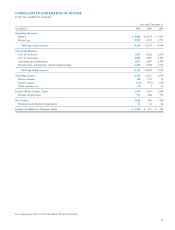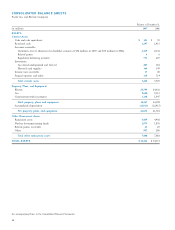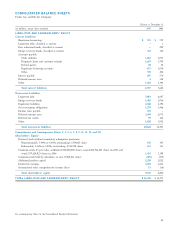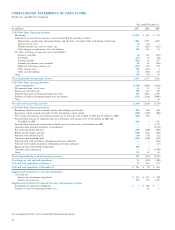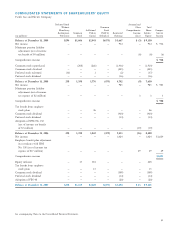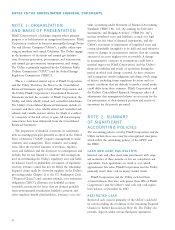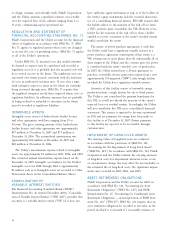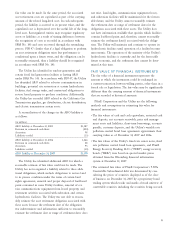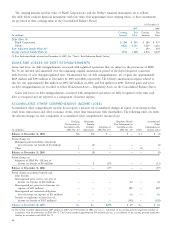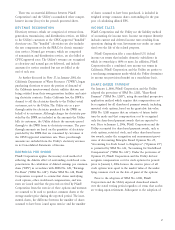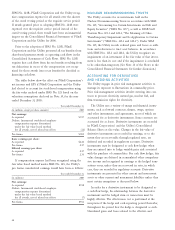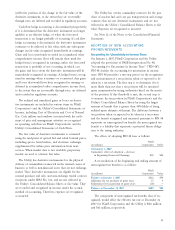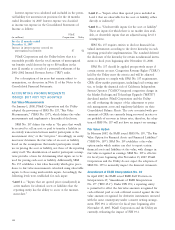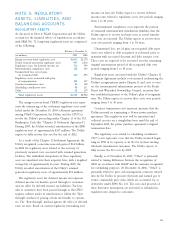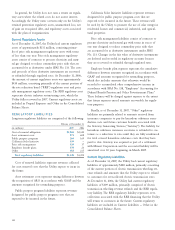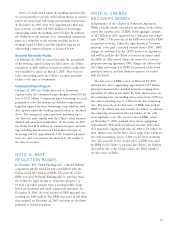PG&E 2007 Annual Report Download - page 99
Download and view the complete annual report
Please find page 99 of the 2007 PG&E annual report below. You can navigate through the pages in the report by either clicking on the pages listed below, or by using the keyword search tool below to find specific information within the annual report.97
There was no material difference between PG&E
Corporation’s and the Utility’s accumulated other compre-
hensive income (loss) for the periods presented above.
REVENUE RECOGNITION
Electricity revenues, which are comprised of revenue from
generation, transmission, and distribution services, are billed
to the Utility’s customers at the CPUC-approved “bundled”
electricity rate. The “bundled” electricity rate also includes
the rate component set by the FERC for electric transmis-
sion services. Natural gas revenues, which are comprised
of transmission and distribution services, are also billed at
CPUC-approved rates. The Utility’s revenues are recognized
as electricity and natural gas are delivered, and include
amounts for services rendered but not yet billed at the
end of each year.
As further discussed in Note 17, in January 2001, the
California Department of Water Resources (“DWR”), began
purchasing electricity to meet the portion of demand of
the California investor-owned electric utilities that was not
being satisfi ed from their own generation facilities and exist-
ing electricity contracts. Under California law, the DWR is
deemed to sell the electricity directly to the Utility’s retail
customers, not to the Utility. The Utility acts as a pass-
through entity for electricity purchased by the DWR on
behalf of its customers. Although charges for electricity pro-
vided by the DWR are included in the amounts the Utility
bills its customers, the Utility deducts the amounts passed
through to the DWR from its electricity revenues. The pass-
through amounts are based on the quantities of electricity
provided by the DWR that are consumed by customers at
the CPUC-approved remittance rate. These pass-through
amounts are excluded from the Utility’s electricity revenues
in its Consolidated Statements of Income.
EARNINGS PER SHARE
PG&E Corporation applies the treasury stock method of
refl ecting the dilutive effect of outstanding stock-based com-
pensation in the calculation of diluted earnings per common
share (“EPS”) in accordance with SFAS No. 128, “Earnings
Per Share” (“SFAS No. 128”). Under SFAS No. 128, PG&E
Corporation is required to assume that shares underlying
stock options, other stock-based compensation, and war-
rants are issued and that the proceeds received by PG&E
Corporation from the exercise of these options and warrants
are assumed to be used to purchase common shares at the
average market price during the reported period. The incre-
mental shares, the difference between the number of shares
assumed to have been issued upon exercise and the number
of shares assumed to have been purchased, is included in
weighted average common shares outstanding for the pur-
pose of calculating diluted EPS.
INCOME TAXES
PG&E Corporation and the Utility use the liability method
of accounting for income taxes. Income tax expense (benefi t)
includes current and deferred income taxes resulting from
operations during the year. Investment tax credits are amor-
tized over the life of the related property.
PG&E Corporation fi les a consolidated U.S. federal
income tax return that includes domestic subsidiaries in
which its ownership is 80% or more. In addition, PG&E
Corporation fi les a combined state income tax return in
California. PG&E Corporation and the Utility are parties to
a tax-sharing arrangement under which the Utility determines
its income tax provision (benefi t) on a stand-alone basis.
SHARE-BASED PAYMENT
On January 1, 2006, PG&E Corporation and the Utility
adopted the provisions of SFAS No. 123R, “Share-Based
Payment” (“SFAS No. 123R”), using the modifi ed prospective
application method which requires that compensation cost
be recognized for all share-based payment awards, including
unvested stock options, based on the grant-date fair value.
SFAS No. 123R requires that an estimate of future forfei-
tures be made and that compensation cost be recognized
only for share-based payment awards that are expected to
vest. Prior to January 1, 2006, PG&E Corporation and the
Utility accounted for share-based payment awards, such as
stock options, restricted stock, and other share-based incen-
tive awards, under the recognition and measurement provi-
sions of Accounting Principles Board Opinion No. 25,
“Accounting for Stock Issued to Employees” (“Opinion 25”)
as permitted by SFAS No. 123, “Accounting for Stock-Based
Compensation” (“SFAS No. 123”). Under the provisions of
Opinion 25, PG&E Corporation and the Utility did not
recognize compensation cost for stock options for periods
prior to January 1, 2006 because the exercise prices of all
stock options were equal to the market value of the under-
lying common stock on the date of grant of the options.
Prior to the adoption of SFAS No. 123R, PG&E
Corporation and the Utility expensed share-based awards
over the stated vesting period regardless of terms that acceler-
ate vesting upon retirement. Subsequent to the adoption of


